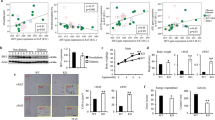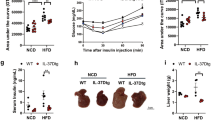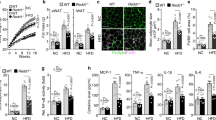Abstract
Objective:
The member of the tumor necrosis factor family LIGHT (lymphotoxin-like inducible protein that competes with glycoprotein D for herpesvirus entry on T cells; TNFSF14 (tumor necrosis factor super family protein 14) is primarily expressed in lymphocytes, in which it induces the expression of pro-inflammatory cytokines and alterations of lipid homeostasis. Recently, the protein was shown to be upregulated in obesity and to induce cytokine secretion from adipocytes.
Research Methods and Procedures:
Using an automated complementary DNA (cDNA) screen, LIGHT was identified to inhibit adipose differentiation. As cellular models for adipogenesis mouse 3T3-L1, human SGBS (Simpson-Golabi-Behmel syndrome) and primary human preadipocytes differentiated in vitro were used as well as primary human adipocytes to study adipocyte functions. Analysis of lipid deposition by Oil Red O staining, mRNA expression by quantitative reverse transcriptase-PCR, nuclear factor (NF)-κB activation as well as protein secretion by enzyme linked immunosorbent assay and Luminex technology was performed.
Results:
LIGHT was found to inhibit lipid accumulation in the three models of preadipocytes in a dose-dependent manner without cytotoxic effects. This inhibition of differentiation was probably because of interference at early steps of adipogenesis, as early exposure during differentiation showed the strongest effect, as assessed by decreased peroxisome proliferator-activated receptor-γ (PPARγ) and CCAAT/enhancer-binding protein-α (C/EBPα) mRNA expression. In contrast to TNFα, basal and insulin-stimulated glucose uptake and lipolysis of terminally differentiated mature adipocytes were not altered in the presence of LIGHT. At a concentration sufficient to inhibit differentiation, secretion of proinflammatory cytokines was not significantly induced and NF-κB activity was only modestly induced compared with TNFα.
Conclusion:
LIGHT is a novel inhibitor of human adipocyte differentiation without adversely influencing central metabolic pathways in adipocytes.
This is a preview of subscription content, access via your institution
Access options
Subscribe to this journal
Receive 12 print issues and online access
$259.00 per year
only $21.58 per issue
Buy this article
- Purchase on Springer Link
- Instant access to full article PDF
Prices may be subject to local taxes which are calculated during checkout







Similar content being viewed by others
References
Hauner H . Secretory factors from human adipose tissue and their functional role. Proc Nutr Soc 2005; 64: 163–169.
Trayhurn P, Wood IS . Signalling role of adipose tissue: adipokines and inflammation in obesity. Biochem Soc Trans 2005; 33: 1078–1081.
Kopelman PG . Obesity as a medical problem. Nature 2000; 404: 635–643.
Pagano C, Calcagno A, Giacomelli L, Poletti A, Macchi V, Vettor R et al. Molecular and morphometric description of adipose tissue during weight changes: a quantitative tool for assessment of tissue texture. Int J Mol Med 2004; 14: 897–902.
Petruschke T, Hauner H . Tumor necrosis factor-alpha prevents the differentiation of human adipocyte precursor cells and causes delipidation of newly developed fat cells. J Clin Endocrinol Metab 1993; 76: 742–747.
Tiller G, Fischer-Posovszky P, Laumen H, Finck A, Skurk T, Keuper M et al. Effects of TWEAK (TNF superfamily member 12) on differentiation, metabolism, and secretory function of human primary preadipocytes and adipocytes. Endocrinology 2009; 150: 5373–5383.
Laumen H, Skurk T, Hauner H . The HMG-CoA reductase inhibitor rosuvastatin inhibits plasminogen activator inhibitor-1 expression and secretion in human adipocytes. Atherosclerosis 2008; 196: 565–573.
Hauner H, Skurk T, Wabitsch M . Cultures of human adipose precursor cells. Methods Mol Biol 2001; 155: 239–247.
Hauner H, Petruschke T, Russ M, Rohrig K, Eckel J . Effects of tumour necrosis factor alpha (TNF alpha) on glucose transport and lipid metabolism of newly-differentiated human fat cells in cell culture. Diabetologia 1995; 38: 764–771.
Zhang B, Berger J, Hu E, Szalkowski D, White-Carrington S, Spiegelman BM et al. Negative regulation of peroxisome proliferator-activated receptor-gamma gene expression contributes to the antiadipogenic effects of tumor necrosis factor-alpha. Mol Endocrinol 1996; 10: 1457–1466.
Bassols J, Moreno-Navarrete JM, Ortega F, Ricart W, Fernandez-Real JM . LIGHT is associated with hypertriglyceridemia in obese subjects and increased cytokine secretion from cultured human adipocytes. Int J Obes 2010; 34: 146–156.
Wang Y, Zhu M, Miller M, Fu YX . Immunoregulation by tumor necrosis factor superfamily member LIGHT. Immunol Rev 2009; 229: 232–243.
Schneider K, Potter KG, Ware CF . Lymphotoxin and LIGHT signalling pathways and target genes. Immunol Rev 2004; 202: 49–66.
Lo JC, Wang Y, Tumanov AV, Bamji M, Yao Z, Reardon CA et al. Lymphotoxin beta receptor-dependent control of lipid homeostasis. Science 2007; 316: 285–288.
Finck BN, Johnson RW . Tumor necrosis factor-alpha regulates secretion of the adipocyte-derived cytokine, leptin. Microsc Res Tech 2000; 50: 209–215.
Lim JY, Kim WH, Park SI . GO6976 prevents TNF-alpha-induced suppression of adiponectin expression in 3T3-L1 adipocytes: putative involvement of protein kinase C. FEBS Lett 2008; 582: 3473–3478.
Acknowledgements
We thank Drs Hoffmann and von Finckenstein and their teams for support in obtaining adipose tissue samples. We are grateful to Dr Kerstin Schnäbele from the Department of Biofunctionality of Foods for access to flow cytometry. We thank Silke Ecklebe and Lydia Gehrke for their excellent technical assistance. PFP is funded by a Margarete von Wrangell scholarship financed by the Baden-Wuerttemberg Ministry of Science, Research and Arts and the European Social Fund. Parts of the project are financed by the German Research Foundation (WA 1096/3-3 to MW).
Author information
Authors and Affiliations
Corresponding author
Ethics declarations
Competing interests
UB, DL and AF were previously employed by Xantos Biomedicine AG, which in part financially supported the Else Kröner-Fresenius-Center for Nutritional Medicine for GT. The remaining authors declare no conflict of interest.
Additional information
Supplementary Information accompanies the paper on International Journal of Obesity website
Supplementary information
Rights and permissions
About this article
Cite this article
Tiller, G., Laumen, H., Fischer-Posovszky, P. et al. LIGHT (TNFSF14) inhibits adipose differentiation without affecting adipocyte metabolism. Int J Obes 35, 208–216 (2011). https://doi.org/10.1038/ijo.2010.126
Received:
Revised:
Accepted:
Published:
Issue Date:
DOI: https://doi.org/10.1038/ijo.2010.126



